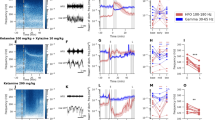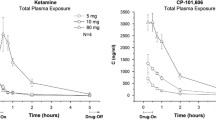Summary
We have investigated the effects of the phencyclidine like-compounds ketamine and MK801 on the evoked field potentials of rat olfactory bulb. Low doses of ketamine (3–6 mg/kg) blocked the inhibition of mitral cells by granule cells evoked by stimulation of lateral olfactory tract fibres or by stimulation of olfactory nerve. This blockade was not accompanied by a decrease in granule cell excitation as revealed by field potential recording. MK801 had a similar effect on the inhibition of mitral cells evoked by stimulation of the lateral olfactory tract. As ketamine does not influence the inhibitory action of GABA (Anis et al. 1983) these results suggest that both ketamine and MK801 block inhibition by an action on intrinsic excitatory feed-back circuits in the olfactory bulb.
Similar content being viewed by others
References
Anis NA, Berry SC, Burton NR, Lodge D (1983) The dissociative anaesthetics, ketamine and phencyclidine selectively reduce excitation of central mammalian neurones by N-methyl-D-aspartate. Br J Pharmacol 79: 565–575
Bowery NG, Wong EHF, Hudson AL (1988) Quantitative autoradiography of (3H)-MK-801 binding sites in mammalian brain. Br J Pharmacol 93: 944–954
Callachan H, Halliwell RF, Hather NY, Lambert JJ, Peters JA (1988) The specificity of action of MK-801. Br J Pharmacol 93:155P
Domino EF (1964) Neurobiology of phencyclidine (sernyl), a drug with an unusual spectrum of pharmacological activity. Int Rev Neurobiol 6: 303
Davies SN, Martin D, Millar JD, Aram JA, Church J, Lodge D (1988) Differences in results from in vivo and in vitro studies on the use-dependency of N-methylaspartate antagonism by MK801 and other phencyclidine receptor ligands. Eur J Pharmacol 145: 141–151
Gage PW, Robertson B (1985) Prolongation of inhibitory currents by pentobarbitone, halothane and ketamine in CA1 pyramidal cells in rat hippocampus. Br J Pharmacol 85: 675–681
Goodwin GM, Metz A (1985) Neuroleptics. In: Grahame-Smith DG (ed) Psychopharmacology 2:1:preclinical psychopharmacology. Elsevier Science Publishers, Amsterdam, pp 206–238
Jacobson I, Butcher S, Hamberger A (1986) An analysis of the effects of excitatory amino acid receptor antagonists on evoked field potentials in the olfactory bulb. Neuroscience 19: 267–273
Jacobson I, Hamberger A (1986) Effects of kynurenic acid on evoked extracellular field potentials in the rat olfactory bulb in vivo. Brain Res 386: 389–392
Jaffé EH, Vaello ML (1989) Release of 3H-GABA from rat olfactory bulb and substantia nigra: differential modulation by glutamic acid. J Neurochem 52: 1766–1774
Jahr CE, Nicoll RA (1982) Noradrenergic modulation of dendrodendritic inhibition in the olfactory bulb. Nature 297: 227–231
Kishi K, Mori K, Ojima H (1984) Distribution of local axon collaterals of mitral, displaced mitral and tufted cells in the rabbit olfactory bulb. J Comp Neurol 225: 511–526
Lodge D, Anis NA (1984) Effects of ketamine and three other anaesthetics on spinal reflexes and inhibitions in the cat. Br J Anaesth 56: 1143
MacRides F, Davis BJ (1983) The olfactory bulb. In: Emson PC (ed) Chemical neuroanatomy. Raven Press, New York, pp 391–426
Manallack DT, Beart PM, Gundlach AL (1986) Psychotomimetic sigma-opiates and PCP. Trends Pharmacol Sci 7: 448–451
McLennan H (1971) The pharmacology of inhibition of mitral cells in the olfactory bulb. Brain Res 29: 177–184
Mori K, Takagi SF (1978) An intracellular study of dendrodendritic inhibitory synapse on mitral cells in the rabbit olfactory bulb. J Physiol 729: 569–588
Nakashima M, Mori K, Takagi S (1978) Centrifugal influence on olfactory bulb activity in the rabbit. Brain Res 154: 301–316
Nicoll RA (1969) Inhibitory mechanisms in the rabbit olfactory bulb: dendrodendritic mechanisms. Brain Res 14: 157–172
Nicoll RA (1970) Recurrent excitatory pathways of anterior commissure and mitral cell axons in the olfactory bulb. Brain Res 19: 491–493
Nicoll RA (1971) Recurrent excitation of secondary olfactory neurons: a possible mechanism for signal amplification. Science 171: 825–826
Nicoll RA (1972) The effects of anesthetics on synaptic excitation and inhibition in the olfactory bulb. J Physiol 223: 803–814
Nicoll RA, Jahr CE (1982) Self-excitation of olfactory bulb neurones. Nature 296: 441–444
Nowycky MC, Halasz N, Shepherd GM (1983) Evoked field potential analysis of dopaminergic mechanisms in the isolated turtle olfactory bulb. Neuroscience 8: 717–722
Oshima E, Richards CD (1988) An in vitro investigation of the action of ketamine on excitatory synaptic transmission in the hippocampus of the guinea-pig. Eur J Pharmacol 148: 25–33
Paxinos G, Watson C (1982) The rat brain in stereotaxic coordinates. Academic Press, London
Rall W, Shepherd GM (1968) Theoretical reconstruction of field potentials and dendrodendritic synaptic interactions in olfactory bulb. J Neurophysiol 31: 884–915
Richards CD (1981) The preparation of brain tissue slices for electrophysiological studies. In: Kerkut GA, Wheal HV (eds) Electrophysiology of isolated mammalian CNS preoaration. Academic Press, London, pp 107–132
Salmoiraghi GC, Bloom FE, Costa E (1964) Adrenergic mechanisms in the rabbit olfactory bulb. Am J Physiol 207: 1417–1424
Shepherd GM (1972) Synaptic organization of the mammalian olfactory bulb. Physiol Rev 52: 864–917
Shimoji K, Fujioka H, Ebata T (1984) Anesthetics block excitation with various effects on inhibition in MFR neurons. Brain Res 295: 190–193
Sircar R, Rappaport M, Nichtenhauser R, Zukin SR (1987) The novel anticonvulsant MK-801: a potent and specific ligand of the brain phencyclidine/o-receptor. Brain Res 435: 235–24
Smith DJ, Bouchai RL, DeSanctis CA, Monroe PJ, Perrotti JM, Crisp T (1987) Properties of the interaction between ketamine and opiate binding sites in vivo and in vitro. Neuropharmacol 26: 1253–1260
Sonders MS, Keana JWF, Weber E (1988) Phencyclidine and psychotomimetic sigma opiates: recent insights into their biochemical and physiological sites of action. Trends Neurosci 11: 37–39
Stewart WB, Scott JW (1976) Anesthetic-dependent field potential interactions in the olfactory bulb. Brain Res 103: 487–499
Stringer JL, Guyenet PG (1982) Effects of phencyclidines on hippocampal pyramidal cells. Brain Res 252: 343–352
Wong HF, Kemp JA, Priestley T, Knight AR, Woodruff GN, Iversen LL (1986) The anticonvulsant MK801 is a potent N-methyl-D aspartate antagonist. Proc Natl Acad Sci USA 83: 7104–7108
Author information
Authors and Affiliations
Rights and permissions
About this article
Cite this article
Jacobson, I., Hamberger, A. & Richards, C.D. Ketamine and MK801 attenuate paired pulse inhibition in the olfactory bulb of the rat. Exp Brain Res 80, 409–414 (1990). https://doi.org/10.1007/BF00228168
Received:
Accepted:
Issue Date:
DOI: https://doi.org/10.1007/BF00228168




